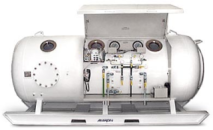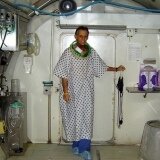Hyperbaric Oxygen Treatment

If applied properly and in time, Hyperbaric Oxygen Treatment proved to be effective in a number of specific conditions.218
All ages can safely be treated in hyperbaric chambers including babies and the elderly, except cases associated with some physical conditions...
Though the main healing factor produced by hyperbaric chamber hyperoxygenation exists only temporary during the Hyperbaric Oxygen treatment, it allows to buy-time for the most intensive natural tissue viability processes to take place and a new blood supply to the damaged body sites to be established.
UHMS Definition of Hyperbaric Oxygen Treatment
"The patient breathes 100% oxygen intermittently while the pressure of the treatment chamber is increased to greater than one atmosphere absolute (atm abs). Current information indicates that pressurization should be at least 1.4 atm abs. This may occur in a single person chamber (monoplace) or multiplace chamber (may hold 2 or more people). Breathing 100% oxygen at 1 atm abs or exposing isolated parts of the body to 100% oxygen does not constitute HBO2 therapy."
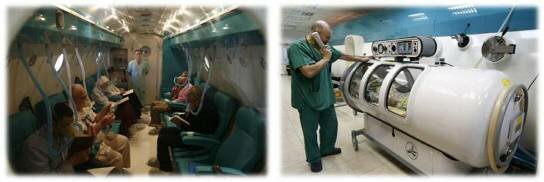
Hyperbaric Oxygen treatment sets into motion cumulative processes promoting immediate and delayed healing activities. The curing effects activated by hyperbaric oxygen do not stop when patient leaves the chamber.
- Patient inhales 100% pure oxygen while atmospheric pressure inside hyperbaric chamber is above 1.4 ATA
- Oxygen concentration in body fluids rises up to 2000% above the normal level equivalent of 1,500-2000 mmHg of arterial oxygen values
- Oxygen-reach plasma transports oxygen to tissues and bones up to 3-4 times deeper then normally
- Body tissues and bones supplied with up to 20 times higher its normal oxygen supply
- From the beginning of HBO treatment immediate as well as delayed secondary effects of healing are promoted
- Increased oxygen saturation of body fluids, mainly plasma, boosts bodys capacity to transport oxygen
- Greater oxygen diffusion distance in tissues and bones promotes over-delivery of vital energy source for cells to maintain their metabolic life. Learn about Aerobic Cellular Respiration...
Delayed secondary effects of Hyperbaric Oxygen Therapy are having prolonged, continued activity of great value...
- fibroblast proliferation which playing a key role in restoring connective tissues
- restored oxygen traffic between ischemic sites and surrounding healthy tissues
- inhibition of toxins in infected tissues present in conditions like gas gangrene or necrosis
- decreasing sites of edema (e.g. fluids accumulated in body tissues or cavities as a result of acute injuries or chronic wounds)
- anti-oxidative actions promoted by oxygen free radicals
- killing anaerobic infections
- formation of new microvascular networks in ischemic tissues, so important in curing chronic wounds, radiation-induced necrosis and other conditions
Hyperbaric Oxygen Treatment Protocols
Hyperbaric Oxygen treatment is usually administrated according to a treatment protocol. Hyperbaric Oxygen is a potent drug, but if administered indiscriminately or improperly instead of beneficial effects it can produce noticeable toxic effects. Therefore a safe time and dose limitations that have been established for hyperbaric oxygen exposure - form the basis for today's treatment protocols. Treatment protocols are specific to medical conditions and are approved by authorized medical authority.
Treatment protocol is a general treatment program established for specific condition types being treated by hyperbaric oxygen. It prescribes core operation parameters such as atmospheric pressure, treatment duration, number of treatments, etc
With the exception of decompression sickness and cerebral arterial gas embolism, treatments last approximately two hours. These treatments may be given once, twice or occasionally three times daily.
Usually Hyperbaric Oxygen treatments for most acute conditions prescribed approximately for 10 days, while chronic conditions may require treatment for 30 or more days. While receiving hyperbaric oxygen therapy, the critically ill patient may be provided with mechanical ventilation, IV therapy and invasive and noninvasive monitoring.
Most treatment protocols for Carbon Monoxide Poisoning require the pressure of 2.5-3 ATA oxygen during 60-100 minutes. 121 Osteoradionecrosis (radiation tissue injury) requires the pressure of 2.5 ATA oxygen during 90 minutes. Treatment protocols for the same condition may vary slightly between numerous hyperbaric medicine providers in public and private sectors.
Consultations with the patients referring doctor are common. During the course of treatment patient usually remains under the supervision of her primary physician.
Complete physical evaluation of patients medical history and current state is conducted by HBOT medical office personnel so that the treatments would be prescribed effectively.
Pre-Treatment Diagnostics
Often there is a requirement to precisely identify ischemic tissue sites. To accomplish this task method known as Transcutaneous Oxygen Measurements (TCPO2) is used.

This non-invasive and precise diagnostic method is especially common before administering hyperbaric oxygen for diabetic wound healing or other wound treatment procedures. The procedure also helps to assess microcirculation of blood in capillaries...
The term transcutaneous means through the skin. The TCPO2 procedure works by comparing multiple measurements of oxygen tension present in tissues in healthy and ischemic sites while breathing first a regular room air and then 100% pure oxygen through an oxygen mask.
TCPO2 method is also instrumental when assessing effectiveness of hyperbaric oxygen treatment.
Preparations Before Hyperbaric Oxygen Treatment
If symptoms of flu or a cold are present, the medical office personnel providing the HBOT treatment should be informed. Symptoms like nausea, vomiting, diarrhea, fever, cold, etc often may be a good reason to postpone the hyperbaric treatment.
Patient should inform a doctor about any drugs being taken because some medications are not compatible with hyperbaric oxygen therapy. Carbonated beverages and alcohol are rather to be avoided for 4-6 hours prior the treatment. Its highly recommended to avoid smoking during the period of hyperbaric treatment because of its negative effect on the oxygen transport to body tissues.
Hyperbaric technician or nurse will help you to adjust medical oxygen mask or hood through which you will breathe the hyperbaric oxygen. Sometimes nasal spray is recommended to clear up nasal passages.
Often in cases of hyperbaric wound treatment a photo images of wounds are taken to monitor the progress of the wound healing.
What To Wear In Hyperbaric Chamber
To insure safety and cleanliness in the Hyperbaric Chamber patients should wear clean 100% cotton clothes or approved anti-static material as per recommendations of established standards for health care facilities (e.g. cotton scrubs, gowns, etc...).
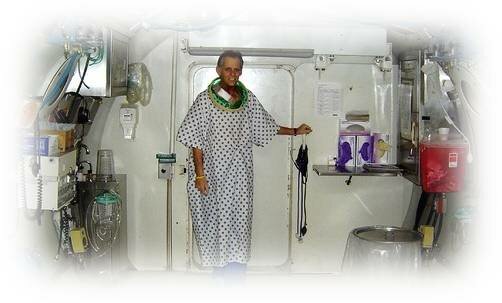
Photo courtesy of Emily Rowlands
What Is Prohibited In Hyperbaric Chamber
Silk, wool, synthetic textile materials capable of creating static electricity are prohibited except those specifically approved for hyperbaric oxygen use.
Petroleum/alcohol-based products, oil-based cosmetic, pacemaker, implanted pumps, and earplugs should not be used in the chamber. Jewelry, combustible materials such as paper, magazines, and excess bedding are not allowed either.
Hyperbaric Oxygen Treatments in Monoplace Chambers vs. Multiplace Hyperbaric Chambers
If treated in monoplace hyperbaric chamber - patient usually does not wear mask, hood or head tent for oxygen delivery rather breathing 100% pure oxygen used to pressurize the chamber. The pressure achieved in monoplace chambers is limited 3 ATA.
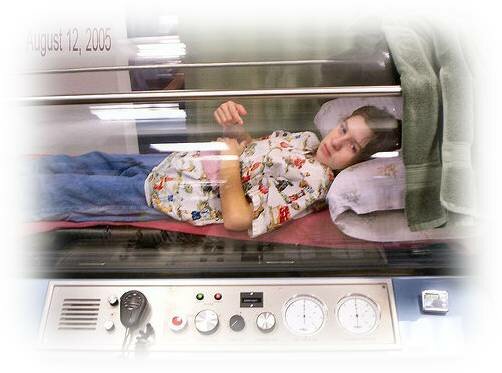
Photo courtesy of McNabbst
Unlike with some multiplace hyperbaric chambers, treatments in monoplace hyperbaric chamber allow treatment protocol to be more flexible in addressing specific patients conditions as well as expanding a treatment program during the course of treatments.
Monoplace chambers pressure compartment is typically a cylindrical metal or acrylic crystal clear tube allowing a person to observe her surroundings and facilitated with increased comfort and mobility features. Read the full article about monoplace chambers
When Hyperbaric Oxygen treatment is conducted in multiplace hyperbaric chambers, the medical oxygen is provided to patients via face oxygen masks or head hood assembly, and air is used to pressurize the chamber.
Multiplace hyperbaric chambers are designed to treat more than one person at a time facilitating treatments under higher internal pressure - up to 6 ATA, which extends the scope of treated conditions. The design patterns, capacity, size, pressure compartments structure and accessories are varying, often because many big multiplace chambers are built to accommodate the hosting hospitals specific requirements.
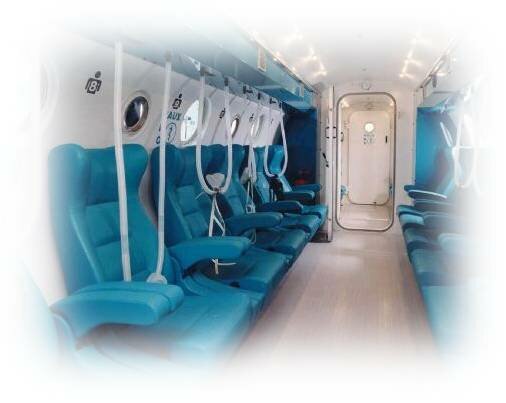
Photo courtesy of Hyperbaric Oxygen Treatment Center At Rambam Hospital
In modern multiplace hyperbaric chambers emergency and intensive care operations may be performed utilizing invaluable healing properties of hyperbaric oxygen. Due to chambers dual rectangular double doors and entry locks - doctors or patients can enter and exit chambers without interrupting the treatment.
Patients on wheel chairs or gurneys can easily being entered inside because chambers compartments are matched to the floor level.
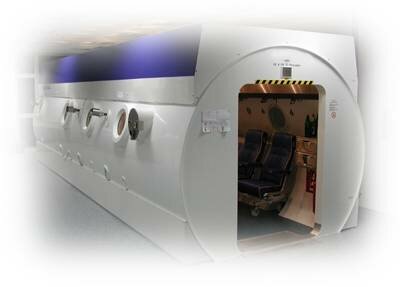
During the 60-90 minutes of hyperbaric treatment, patients may relax listening to music, watching TV, DVD, reading or just sleeping
As pure 100% oxygen starts coming into a chamber accompanying by gentle tss sound, the internal pressure slowly develops and the patient might feel a slight warming. Similar to the descent of an airplane, patients can develop a fullness or pressure feeling in their ears.
Special techniques are to be learned to reduce uncomfortable effects When pressure goes down by the end of the Hyperbaric Oxygen treatment patients might feel chilly. The temperature changes are well explained by physics laws
Click on the image below to learn more about Hyperbaric Chambers...
